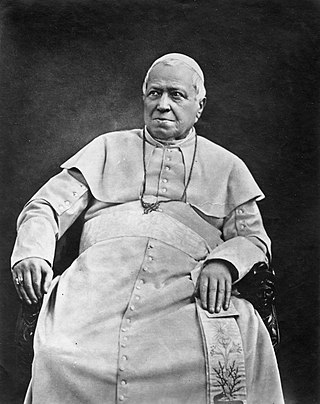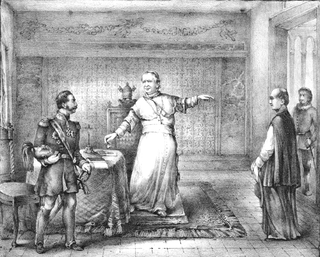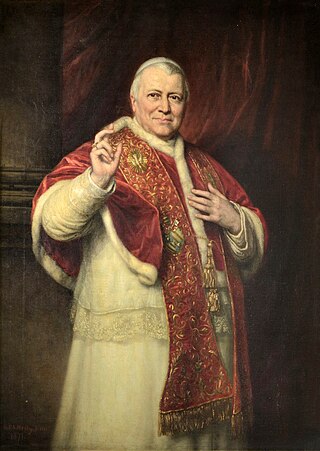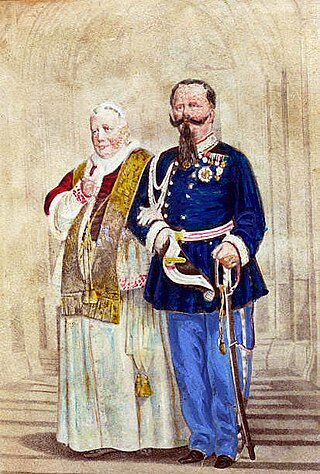
In the time of Pope Pius IX, Poland had long been partitioned among three neighbouring powers and no longer existed as an independent country. The Polish people lived under the rule of the Russian Empire, the Austrian Empire and Prussia.

In the time of Pope Pius IX, Poland had long been partitioned among three neighbouring powers and no longer existed as an independent country. The Polish people lived under the rule of the Russian Empire, the Austrian Empire and Prussia.
The major part of the difficulties that the Pope faced with regard to the Polish people concerned those who were ruled by the Tsar. They faced discrimination and persecution at the hands of the government, which enforced Russification and attempted to separate priests and people from their church. [1]
For the sake of good relations with the government, Pius opposed the Polish nationalist movements that were often making those relations tense. On the other hand, his protests against the government's actions in its Polish provinces were so strong that they led to an intervention by the Austrian Empire, another of the powers who had taken over part of Poland, with the aim of getting the Pope to be silent on the matter.
Faced with problems from revolutionary movements in his Papal States, Pope Pius first tried to position himself in the middle, strongly opposing revolutionary and violent opposition against the governing authorities, while appealing to these for greater Church freedom. After the failure of the Polish uprising in 1863, he sided with the persecuted Poles, loudly protesting their persecution, infuriating the Tsarist government to the point that all Catholic sees were closed by 1870. [2]
Pope Pius opposed Polish protests in 1860 against Russian rule in the part of Poland that fell to Russia in the partitions of Poland, protests allegedly stimulated by the anti-papal mysticism of philosopher Andrzej Towiański and influenced by Adam Mickiewicz.[ citation needed ]
On June 6, 1861, Pope Pius IX wrote to Archbishop Antoni Melchior Fijałkowski, complaining against unjust accusations by Polish nationalists and enumerating all he had done for the Polish people in the Russian Empire. [3] The Pope repeated his position, that Poles living under Russian rule had to obey Russian laws, while the Russian government had to provide religious freedom. [3]
His dualistic appeals for Polish moderation and religious freedom did not appease either party. Russia felt strong on its territory, and Poles had national aspirations, for which they used Catholic churches to meet, talk and inspire emotions with patriotic songs. Continued incidences[ spelling? ] convinced the assembled cardinals in the Vatican on December 7, 1861, that the conflict was political in nature. Religion was simply a pretext for national Polish aspirations. They advised the Pope to be reluctant in his utterances. [4]
The conflict continued inside the Church and with the Russian government, which, however, established diplomatic relations with the Holy See in 1861. When the Catholic metropolitan, supported by Antoni Melchior Fijałkowski, banned patriotic Polish songs in churches, he was labelled a traitor, without gaining much support from the government. The mutual mistrust, persecution and the opening and closing of monasteries and dioceses continued in the following years. [5] However, since the papal delegate was not allowed to have any contact with the clergy, Pope Pius IX recalled his nuncio in 1863. [6] After the Polish uprising in the same year, Pope Pius IX on April 22, 1863, wrote to the Tsar, protesting the expropriation of Church properties, forced conversions and the jailing of the clergy.
Tsar Alexander II replied that only politically revolutionary elements were punished. On August 20, the Pope protested and ordered a prayer novena for the persecuted Church. But the persecutions worsened: 330 priests were deported, a war tax was imposed on the clergy, and 114 Catholic monasteries were closed.
Protests by Pope Pius enraged the Tsar and his regime, and led to an Austrian intervention, urging the Pope to be silent in the interest of the Polish Catholics. The Pope abstained from public protests but issued an encyclical July 30, 1863, in which he praised the heroic fight of the Poles and enumerated destruction and persecution activities by the Russian authorities. [7] In the aftermath, Russia closed the dioceses of Kamieniec Podolski, and banned or exiled bishops and administrators in Warsaw, Chełm and other dioceses. On November 15, 1863, the Vatican published a White Book with some one hundred documents, detailing the conflict. Russia answered with a break of the concordat on December 6, 1863. By 1870, not a single bishop from the Polish provinces of the Russian empire was left in his own diocese. [1]
Unlike the Poles in the Eastern Orthodox Russian Empire, those who belonged to the Catholic Austrian Empire were able to fully live their faith. [1]
| | This section is empty. You can help by adding to it. (July 2010) |

Pope Pius IX was head of the Catholic Church from 1846 to 1878. His reign of 32 years is the second longest of any pope in history, behind that of Saint Peter. He was notable for convoking the First Vatican Council in 1868 and for permanently losing control of the Papal States in 1870 to the Kingdom of Italy. Thereafter, he refused to leave Vatican City, declaring himself a "prisoner in the Vatican".

Pope Pius XI, born Ambrogio Damiano Achille Ratti, was the Bishop of Rome and supreme pontiff of the Catholic Church from 6 February 1922 to 10 February 1939. He also became the first sovereign of the Vatican City State upon its creation as an independent state on 11 February 1929. He remained head of the Catholic Church until his death in February 1939. His papal motto was "Pax Christi in Regno Christi", translated as "The Peace of Christ in the Reign of Christ".

Pietro Gasparri was a Roman Catholic cardinal, diplomat and politician in the Roman Curia and the signatory of the Lateran Pacts. He served also as Cardinal Secretary of State under Popes Benedict XV and Pope Pius XI.
Persecutions against the Catholic Church took place during the papacy of Pope Pius XII (1939–1958). Pius' reign coincided with World War II (1939–1945), followed by the commencement of the Cold War and the accelerating European decolonisation. During his papacy, the Catholic Church faced persecution under Fascist and Communist governments.
Pope Pius XII and Poland includes Church relations from 1939 to 1958. Pius XII became Pope on the eve of the Second World War. The invasion of predominantly Catholic Poland by Nazi Germany in 1939 ignited the conflict and was followed soon after by a Soviet invasion of the Eastern half of Poland, in accordance with an agreement reached between the dictators Joseph Stalin and Adolf Hitler. The Catholic Church in Poland was about to face decades of repression, both at Nazi and Communist hands. The Nazi persecution of the Catholic Church in Poland was followed by a Stalinist repression which was particularly intense through the years 1946–1956. Pope Pius XII's policies consisted in attempts to avoid World War II, extensive diplomatic activity on behalf of Poland and encouragement to the persecuted clergy and faithful.
The 1925 concordat (agreement) between the Holy See and the Second Polish Republic had 27 articles, which guaranteed the freedom of the Church and the faithful. It regulated the usual points of interests, Catholic instruction in primary schools and secondary schools, nomination of bishops, establishment of seminaries, a permanent nuncio in Warsaw, who also represents the interests of the Holy See in Gdańsk. It was considered one of the most favorable concordats for the Holy See, and would become a basis for many future concordats.

Pope Pius IX and Russia includes the relations between the Pontiff and the Russian Empire during the years 1846–1878.

Vatican during the Savoyard era describes the relation of the Vatican to Italy, after 1870, which marked the end of the Papal States, and 1929, when the papacy regained autonomy in the Lateran Treaty, a period dominated by the Roman Question.

Holy See–Soviet Union relations were marked by long-standing ideological disagreements between the Catholic Church and the Soviet Union. The Holy See attempted to enter in a pragmatic dialogue with Soviet leaders during the papacies of John XXIII and Paul VI. In the 1990s, Pope John Paul II's diplomatic policies were cited as one of the principal factors that led to the dissolution of the Soviet Union.
The 1847 Agreement between the Holy See and the Russian Empire was a diplomatic arrangement entered into on 3 August of that year.
The relationship between Pope Leo XIII and Russia was characterized by attempts by the Holy See to secure greater Church rights for Catholics in the Russian Empire.
The relationship between Pope Pius XI and Poland is often considered to have been good, as Church life in Poland flourished during his pontificate.
The relations between Pope Pius X and Russia were difficult, and the situation of Polish Catholics in Russia did not improve.

Zygmunt Szczęsny Feliński was a professor of the Saint Petersburg Roman Catholic Theological Academy, Archbishop of Warsaw in 1862-1883 ,and founder of the Franciscan Sisters of the Family of Mary. He was canonised on 11 October 2009 by Pope Benedict XVI.
The relationship between Pope Pius IX and the United States was an important aspect of the pontiff's foreign policy and Church growth program.

Foreign relations between Pope Pius IX and Italy were characterized by an extensive political and diplomatic conflict over Italian unification and the subsequent status of Rome after the victory of the liberal revolutionaries.

The theology of Pope Pius IX championed the pontiff's role as the highest teaching authority in the Church.
The Papal States under Pope Pius IX assumed a much more modern and secular character than had been seen under previous pontificates, and yet this progressive modernization was not nearly sufficient in resisting the tide of political liberalization and unification in Italy during the middle of the 19th century.

During the German Occupation of Poland (1939–1945), the Nazis brutally suppressed the Catholic Church in Poland, most severely in German-occupied areas of Poland. Thousands of churches and monasteries were systematically closed, seized or destroyed. As a result, many works of religious art and objects were permanently lost.
In the Roman Catholic Church, a papal allocution is a solemn, private form of address or speech employed by the Pope on certain occasions. Historically, papal allocutions were delivered only in a secret consistory of cardinals; popes since Pope Pius IX have made increasing use of allocutions, and modern allocutions may be delivered in private to any group.